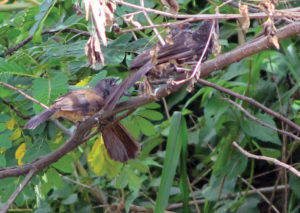Butterflies are some of the most beautiful insects on earth. Fluttering their coloured and patterned wings, these charming creatures arouse awe and a sense of harmony wherever they fly. The Taita Hills forests are home to many of these flying beauties. As a matter of fact, there are three butterfly species that are endemic to these forests – found nowhere else on Earth.
Chawia forest is among the three remaining large forest fragments in the Taita Hills. At the fringe of this forest, a group of youth is engaged in butterfly farming, proving that there’s a financial stake in keeping the forest intact. Comprising of 14 members, the Chawia Youth Group rears and sells butterfly pupae as one of its core livelihood activities. What sets this group apart from others is its determination to keep Chawia forest conserved by encouraging the planting of indigenous trees.
“This forest is very important to us because the butterfly species found here are dependent on it and its indigenous trees,” explains Amos Mwamburi, a member of the group.
The group considers conservation of Chawia forest a priority as it is directly linked to their livelihoods. The group has a tree nursery with over 4,000 seedlings, mostly indigenous ones. This year they are planning to plant 1,000 trees as part of their forest restoration initiative. The trees intended for planting are those mostly preferred by butterflies. In addition, each member of group has planted trees in their farms.
To raise butterflies, they start with butterfly eggs, which hatch into tiny caterpillars. The caterpillars feed on the leaves of certain forest trees. They grow and grow. When they are big enough, the caterpillars turn into pupae. Inside the pupa, the caterpillar transforms into a. butterfly. After a few days or weeks, the adult butterfly will hatch from the pupa.
More than 25 types of butterflies inhabit Chawia forest, including Cymothoe teita and Papilio desmondi teita, a subspecies of Desmond’s Green-banded Swallowtail. These two butterflies are endemic to Taita Hills forests. Some species of swallowtails and pansies can also be found in Chawia forest.
According to Mwamburi, on average the group sells around 200 butterfly pupae per month, translating to Ksh.11,000. The pupae are either sold to Kipepeo Centre in Gede near Malindi or to brokers, depending on the butterfly type. The pupae are in turn exported abroad for live exhibits. Kenya has over 800 butterfly species and is ranked among the world’s leading producers of pupae.
“One good thing about butterflies is that they lay many eggs. A single butterfly can lay up to 150-200 eggs, and if these manage to reach the pupae stage, we are talking of over 100 pupae from just one butterfly,” says Mwamburi.
Although the group’s members rear two of the Taita endemic butterflies, Mwamburi is quick to point out that they do not sell their pupae.
“We do not sell the Papilio desmondi teita and Cymothoe teita pupae. We release adults of these two butterfly subspecies into the wild to increase their numbers,” he says.
Butterfly farming has enabled Mwamburi and his colleagues to not only earn a livelihood but also to actively advocate for conservation of Chawia forest.
“We carry out awareness activities around here, where we encourage community members to plant indigenous trees in their farms. People are now beginning to appreciate the importance of conserving our forests which also serve as sources of water. We stand to lose a lot if these forests are destroyed,” he adds.
Like the other surviving indigenous cloud forests of Taita Hills, Chawia has suffered substantial vegetation loss and degradation over the years. Currently, only about 86 ha of the original Chawia forest remains.
The Taita Hills comprise two main mountain massifs, Mbololo and Dawida, rising from the dryland below. The forests that remain on the hilltops are extensively fragmented. Taita Hills forests are part of the Eastern Arc, one of 34 global biodiversity hotspots, and are ranked as one of Kenya’s Key Biodiversity Areas (KBAs). Two Critically Endangered birds are only found in these forest remnants: Taita Thrush (Turdus helleri) and Taita Apalis (Apalis (thoracica) fuscigularis). Severe fragmentation, isolation and decline in quality and extent of indigenous forest cover in Taita Hills pose major threats which affect the breeding success and survival of the two bird species. Helping the community to conserve the forests is therefore vitally important.
Nature Kenya, under the ‘People Partner with Nature’ program, has been supporting communities living adjacent to the Taita Hills forests to engage in income generating activities, such as butterfly farming, beekeeping, eco-tourism, among others, that reduce pressure on the environment. The program is being implemented in partnership with DOF (BirdLife in Denmark) with financial support from DANIDA/ CISU. The overall objective of the program is to ‘reduce the destruction of forested KBAs and contribute to the realization of best participatory forest management practices for the benefit of all.’ This program is also running in Arabuko- Sokoke Forest and Dakatcha Woodland in Kilifi county.

 Following the initial sightings of Hinde’s Babblers at the University of Nairobi’s Upper Kabete Field Station on 26th February (Simon Carter and David Guarnieri) and 8th March 2017 (Nature Kenya Wednesday Morning Bird Walk), marking the first official records of the species in Nairobi, I have been monitoring the birds as I am a student at UoN Upper Kabete Campus. On one occasion while observing the birds with Allan Kipruto (a schoolmate), we got a brief glimpse of what seemed to be a very orange-looking individual in the bushes where the rest of the Babblers (4 adults) were noisily moving around. We suspected it was a juvenile but couldn’t confirm since it quickly went deep into the bush and did not re-emerge.
Following the initial sightings of Hinde’s Babblers at the University of Nairobi’s Upper Kabete Field Station on 26th February (Simon Carter and David Guarnieri) and 8th March 2017 (Nature Kenya Wednesday Morning Bird Walk), marking the first official records of the species in Nairobi, I have been monitoring the birds as I am a student at UoN Upper Kabete Campus. On one occasion while observing the birds with Allan Kipruto (a schoolmate), we got a brief glimpse of what seemed to be a very orange-looking individual in the bushes where the rest of the Babblers (4 adults) were noisily moving around. We suspected it was a juvenile but couldn’t confirm since it quickly went deep into the bush and did not re-emerge.